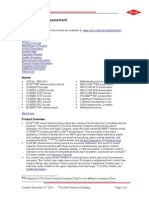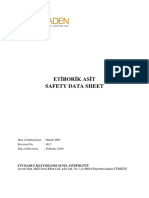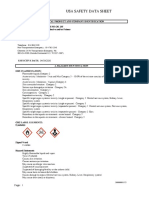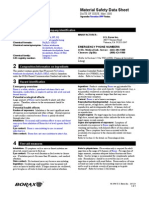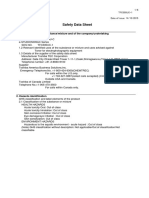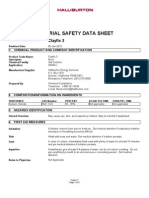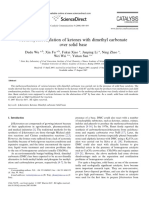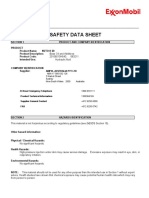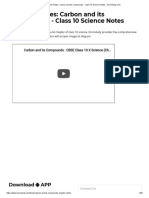Trimethyl Borate: Product Safety Assessment
Trimethyl Borate: Product Safety Assessment
Uploaded by
BobyEsterandoCopyright:
Available Formats
Trimethyl Borate: Product Safety Assessment
Trimethyl Borate: Product Safety Assessment
Uploaded by
BobyEsterandoOriginal Description:
Original Title
Copyright
Available Formats
Share this document
Did you find this document useful?
Is this content inappropriate?
Copyright:
Available Formats
Trimethyl Borate: Product Safety Assessment
Trimethyl Borate: Product Safety Assessment
Uploaded by
BobyEsterandoCopyright:
Available Formats
Product Safety Assessment
Trimethyl Borate
Product Safety Assessment documents are available at
www.dow.com/productsafety/assess/finder.htm.
Select a Topic:
Names
Product Overview
Manufacture of Product
Product Description
Product Uses
Exposure Potential
Health Information
Environmental Information
Physical Hazard Information
Regulatory Information
Additional Information
References
Names
CAS No. 121-43-7
Trimethyl borate
Boric acid, trimethyl ester
Methyl borate
Trimethyl borate azeotrope
Trimethoxyborane
Back to top
Product Overview
Trimethyl borate (TMB) is a colorless, clear liquid of relatively pure (>99 %) trimethyl borate. It is miscible with most organic liquids.
1,2
It is also available as a 70% solution in methanol (CAS No. 67-56-1) known as TMB azeotrope. For further details, see Product
Description.
Trimethyl borate is used in the production of complex molecules for pharmaceuticals and other products via Suzuki chemistry,
3
which are increasingly used in the synthesis of active ingredients for agrochemical and pharmaceutical use. For further details,
see Product Uses.
1,4
Dow does not sell trimethyl borate for direct consumer use. Direct consumer contact with this product is unlikely. For further
details, see Exposure Potential.
Contact may cause moderate eye or skin irritation. This product may be harmful if absorbed through the skin. Inhalation of vapor or
mist may cause irritation of the nose, throat, and lungs, headache, nausea, vomiting, dizziness, drowsiness, and lack of
coordination. Swallowing this product may cause headache, dizziness, and lack of coordination as well as gastrointestinal
1
irritation. For further details, see Health Information.
Trimethyl borate will not persist in the environment. The compound reacts rapidly with water to form methanol, hydrogen gas and
boric acid. These compounds have a low bioconcentration potential and are not likely to accumulate in the food chain. Methanol is
1,5,6
practically non-toxic to aquatic organisms on an acute basis while boric acid is considered moderately toxic.
For further details,
see Environmental Information.
Trimethyl borate is stable under recommended storage and normal use conditions. Avoid contact with water. Avoid contact with
1
oxidizing agents and acids. This product is flammable as liquid and vapor. For further details, see Physical Hazard Information.
Back to top
TM
Trademark of the Dow Chemical Company (Dow) or an affiliated company of Dow
Revised: July 30, 2014
The Dow Chemical Company
Page 1 of 5
Product Safety Assessment: Trimethyl Borate
Manufacture of Product
Location Rohm and Haas Company, a wholly owned subsidiary of The Dow Chemical Company, and its global affiliates
manufacture trimethyl borate in the U.S.A.
Process Trimethyl borate is produced from boric acid and methanol.
Back to top
1,2
Product Description
Trimethyl borate (TMB) is a colorless, clear liquid of relatively pure (>99 %) trimethyl borate. It is miscible with most organic liquids and
hydrolyzes rapidly in water to form methanol and boric acid. It is also available as a 70% solution in methanol (CAS No. 67-56-1) known
as TMB azeotrope.
Back to top
3,6
Product Uses
Trimethyl borate is a precursor to boronics, which are chemicals used in Suzuki coupling. It is used in the production of complex
molecules for pharmaceuticals and other products using Suzuki chemistry, which are increasingly used in the synthesis of active
ingredients for agrochemical and pharmaceutical use. Trimethyl borate can also be used as a solvent or dehydrating agent.
Back to top
1,4
Exposure Potential
Trimethyl borate is used in the production of industrial products. Based on the uses for this product, individuals could be exposed
through:
Workplace exposure Exposure can occur either in facilities that manufacture trimethyl borate or in the various industrial or
manufacturing facilities that use this product. Trimethyl borate is produced, transported, and stored in closed containers until time
for use. Those working with trimethyl borate in manufacturing operations could be exposed during maintenance, sampling, testing,
or other procedures. Each manufacturing facility should have a thorough training program for employees and appropriate work
processes, ventilation, and safety equipment in place to limit exposure. See Health Information.
Consumer exposure to products containing trimethyl borate Dow does not sell trimethyl borate for direct consumer use.
Direct consumer contact with this product is unlikely.
Environmental releases Releases of trimethyl borate to the environment are expected to be limited since most of the product is
used in closed systems. Releases to the environment would result in trimethyl borate reacting rapidly with water or moisture in the
air resulting in the release of methanol, hydrogen gas, and boric acid. Since methanol is readily biodegradable, it would be
removed from water and soil environments, including wastewater treatment facilities. Hydrogen would rapidly volatilize to the
atmosphere while boric acid would remain in the aqueous environment. Keep spills and cleaning runoff out of municipal sewers
and open bodies of water. Contain spills immediately with inert materials (e.g. sand, earth). Transfer liquids and solid diking
material to separate, suitable containers for recovery or disposal. Environmental, Health, and Physical Hazard Information.
Large release Industrial spills or releases are infrequent and generally contained. If a large spill does occur, the product should
be captured, collected, and reprocessed or disposed of according to applicable governmental requirements. An approved positivepressure, self-contained breathing apparatus (SCBA) with a full-face mask is recommended for emergency work. Eliminate all
sources of ignition immediately. Use only explosion-proof equipment; ground and bond all containers and handling equipment. See
Environmental, Health, and Physical Hazard Information.
In case of fire Trimethyl borate is flammable. Store away from potential sources of ignition. Deny any unnecessary entry into the
area. Use water spray or fog, carbon-dioxide or dry-chemical extinguishers, or foam to fight the fire. Use of a direct water stream
may spread the fire and will produce flammable materials as the product hydrolyzes. Toxic vapors may be produced when this
product is heated or burned. Firefighters should wear positive-pressure, self-contained breathing apparatus (SCBA) and protective
firefighting clothing. Keep vapors out of sewers. Vapors are heavier than air and may travel a long distance and accumulate in lowlying areas. The public should be warned of downwind vapor explosion hazards. Immediately withdraw all personnel from the area
in case of rising sounds from venting safety device or discolorations of the container. Keep fire water out of waterways and sewers
to minimize the potential for environmental damage. Follow emergency procedures carefully. See Environmental, Health, and
Physical Hazard Information.
For more information, see the relevant Safety Data Sheet.
Back to top
TM
Trademark of the Dow Chemical Company (Dow) or an affiliated company of Dow
Revised: July 30, 2014
The Dow Chemical Company
Page 2 of 5
Product Safety Assessment: Trimethyl Borate
Health Information
Eye contact Contact may cause moderate irritation.
Skin contact Contact may cause moderate irritation. Prolonged or repeated contact with liquid may cause defatting of the skin
resulting in dryness, redness, and possible blistering. This product may be harmful if absorbed through the skin.
Inhalation Inhalation of vapor or mist may cause irritation of the nose, throat, and lungs, headache, nausea, vomiting, dizziness,
drowsiness, and lack of coordination.
Ingestion Swallowing this product may cause headache, dizziness, and lack of coordination, as well as gastrointestinal irritation,
abdominal pain, nausea, vomiting, and diarrhea.
For more information, see the relevant Safety Data Sheet.
Back to top
1,6,7
Environmental Information
Trimethyl borate reacts rapidly with water or moisture in the air to form methanol, hydrogen gas, and boric acid. The methanol and
boric acid will tend to remain in water with little tendency to bind to soil or sediment, while hydrogen will volatilize to the atmosphere.
Trimethyl borate will not persist in the environment due to its rapid reaction with water. Since methanol is readily biodegradable, it
would be removed from water and soil environments, including wastewater treatment facilities.
Methanol, hydrogen, and boric acid have a low bioconcentration potential and are not likely to accumulate in the food chain. Methanol is
practically non-toxic to aquatic organisms on an acute basis (LC50/EC50 >100 mg/L) while boric acid is considered moderately toxic
(LC50/EC50 between 1 and 10 mg/L for the most sensitive species).
For more information, see the relevant Safety Data Sheet.
Back to top
1
Physical Hazard Information
Trimethyl borate is considered stable under recommended storage and normal use conditions. Avoid contact with water. Trimethyl
borate rapidly reacts in the presence of water.
Trimethyl borate is flammable as liquid and vapor. Store away from excessive heat and potential sources of ignition. Avoid contact with
oxidizing agents and acids.
For more information, see the relevant Safety Data Sheet.
Back to top
Regulatory Information
Regulations may exist that govern the manufacture, sale, transportation, use, and/or disposal of trimethyl borate. These regulations
may vary by city, state, country, or geographic region. Information may be found by consulting the relevant Safety Data Sheet,
Technical Data Sheet, or Contact Us.
Back to top
TM
Trademark of the Dow Chemical Company (Dow) or an affiliated company of Dow
Revised: July 30, 2014
The Dow Chemical Company
Page 3 of 5
Product Safety Assessment: Trimethyl Borate
Additional Information
Safety Data Sheet (www.dow.com/webapps/msds/msdssearch or www.dow.com/products/msds/10035083)
Contact Us (www.dow.com/assistance/dowcig)
Trimethyl Borate Pure Technical Data Sheet, The Dow Chemical Company (http://www.dow.com/products/product/trimethyl-boratepure/)
Trimethyl Borate Pure: Precursor for Boronic Acids/Esters, Rohm and Haas Company, October 2005
(www.dow.com/assets/attachments/business/process_chemicals/coupling_precursors/trimethyl_borate_pure/docs/TrimethylBorate
Pure[1].pdf)
Product List for Borohydride and Companion Products, The Dow Chemical Company, Form No. 844-00018
(http://www.dow.com/productsafety/assess/finder.htm)
Methanol CAS: 67-56-1, Screening Information Data Set (SIDS) Initial Assessment Report for SIAM 19, Organisation for
Economic Co-operation and Development (OECD), United Nations Environment Programme (UNEP): Berlin, Germany, October
18-20, 2004 (http://webnet.oecd.org/Hpv/UI/SIDS_Details.aspx?id=39B5D34A-2F5D-4D53-B000-E497B3A3EE89)
Trimethyl Borate, CASRN: 121-43-7, Hazardous Substances Data Bank (HSDB), U.S. National Library of Medicine, TOXNET
(http://www.echemportal.org/echemportal/substancesearch/substancesearchlink.action;jsessionid=E6205C570353A5C6492576C0
318A6180)
For more business information about trimethyl borate, visit the website for VenPure Products for Fine Chemical Synthesis at
www.dow.com/sbh/ or www.hydridesolutions.com.
Back to top
References
1
Trimethyl Borate Material Safety Data Sheet, The Dow Chemical Company
2
Product List for Borohydride and Companion Products, The Dow Chemical Company, Form No. 844-00018
3
Trimethyl Borate Pure: Precursor for Boronic Acids/Esters Technical Data Sheet, Rohm and Haas Company
4
Trimethyl Borate, International Chemical Safety Cards, National Institute for Occupational Safety and Health, April 4, 2006, pages 1
and 2.
5
Screening Information Data Set (SIDS) Initial Assessment Report for SIAM 19, Methanol CAS: 67-56-1, Organisation for Economic
Co-operation and Development (OECD), United Nations Environment Programme (UNEP): Berlin, Germany, October 1820, 2004,
pages 5 and 6.
6
Trimethyl Borate CASRN: 121-43-7, Hazardous Substances Data Bank (HSDB), U.S. National Library of Medicine, TOXNET,
Environmental Fate & Exposure section.
7
Methanol CAS: 67-56-1, Screening Information Data Set (SIDS) Initial Assessment Report for SIAM 19, Organisation for Economic
Co-operation and Development (OECD), United Nations Environment Programme (UNEP): Berlin, Germany, October 1820, 2004,
pages 5 and 6.
TM
Trademark of the Dow Chemical Company (Dow) or an affiliated company of Dow
Revised: July 30, 2014
The Dow Chemical Company
Page 4 of 5
Product Safety Assessment: Trimethyl Borate
NOTICES
As part of its 2015 Sustainability Goals, Dow has committed to make publicly available safety assessments for its products globally.
This product safety assessment is intended to give general information about the chemical (or categories of chemicals) addressed. It is
not intended to provide an in-depth discussion of health and safety information. Additional information is available through the relevant
Safety Data Sheet, which should be consulted before use of the chemical. This product safety assessment does not replace required
communication documents such as the Safety Data Sheet.
The information herein is supplied upon the condition that the persons receiving same will make their own determination as to its
suitability for their purposes prior to use. In no event will Dow be responsible for damages of any nature whatsoever resulting from the
use of or reliance upon the information herein or the product to which that information refers.
Nothing contained herein is to be construed as a recommendation to use any product, process, equipment or formulation in conflict with
any patent, and Dow makes no representation or warranty, express or implied, that the use thereof will not infringe any patent.
NO REPRESENTATIONS OR WARRANTIES, EITHER EXPRESS OR IMPLIED, OF MERCHANTABILITY, FITNESS FOR A
PARTICULAR PURPOSE OR OF ANY OTHER NATURE ARE MADE HEREUNDER WITH RESPECT TO INFORMATION OR THE
PRODUCT TO WHICH INFORMATION REFERS.
Dow makes no commitment to update or correct any information that appears on the Internet or on its World-Wide Web server. The
information contained in this document is supplemental to the Internet Disclaimer, www.dow.com/homepage/term.asp.
Back to top
Form No. 233-01028-MM-0714X
TM
Trademark of the Dow Chemical Company (Dow) or an affiliated company of Dow
Revised: July 30, 2014
The Dow Chemical Company
Page 5 of 5
You might also like
- Trichloroethylene - Safety DatasheetDocument4 pagesTrichloroethylene - Safety DatasheetlutzzNo ratings yet
- Diethyl Ether Gps Safety SummaryDocument5 pagesDiethyl Ether Gps Safety SummaryJallu PratamaNo ratings yet
- Assessment of Route BDocument4 pagesAssessment of Route BBeatrix LeeNo ratings yet
- Propylene Carbonate at Dow ChemicalsDocument6 pagesPropylene Carbonate at Dow Chemicalsjangri1098No ratings yet
- Material Safety Data Sheet: TrichloroethyleneDocument6 pagesMaterial Safety Data Sheet: TrichloroethylenefructoraNo ratings yet
- Norlube 3030 MSDSDocument5 pagesNorlube 3030 MSDSrenebbNo ratings yet
- TrimethylolpropaneDocument3 pagesTrimethylolpropaneeliteindustries.pkNo ratings yet
- Butadiene: Product Safety AssessmentDocument7 pagesButadiene: Product Safety AssessmentchenhetingNo ratings yet
- DOWANOLTM DPM Glycol EtherDocument5 pagesDOWANOLTM DPM Glycol EtherNanang BumimasNo ratings yet
- DOW™ Crude Butadiene: Product Safety AssessmentDocument6 pagesDOW™ Crude Butadiene: Product Safety AssessmentJulian Vargas EcheverryNo ratings yet
- Material Safety Data Sheet: Tetramethyl LeadDocument6 pagesMaterial Safety Data Sheet: Tetramethyl LeadfructoraNo ratings yet
- Boric Acid, American Borate Co - SDSDocument10 pagesBoric Acid, American Borate Co - SDSMichaelNo ratings yet
- Komatsu Diesel Engine Oil EO 15W-40 LA: Safety Data SheetDocument7 pagesKomatsu Diesel Engine Oil EO 15W-40 LA: Safety Data SheetPierre LunaNo ratings yet
- SDS-Yellow Iron Oxide 569Document5 pagesSDS-Yellow Iron Oxide 569Chima ElokaNo ratings yet
- Toluene DiisocyanateDocument8 pagesToluene DiisocyanateKaka BabaNo ratings yet
- Dowtherm SR-1 (Ingles)Document13 pagesDowtherm SR-1 (Ingles)Jana DmitrievaNo ratings yet
- Vulkacit ThiuramDocument4 pagesVulkacit Thiuramdiamondtyre111No ratings yet
- MitDocument7 pagesMitLam LagNo ratings yet
- Material Safety Data Sheet: 1. Product Identification TiltDocument6 pagesMaterial Safety Data Sheet: 1. Product Identification TiltJurgen SchirmacherNo ratings yet
- s1813 Photoresist SdsDocument15 pagess1813 Photoresist Sds陳博義No ratings yet
- Remove Bad Smell From Septic TankDocument3 pagesRemove Bad Smell From Septic TankAlen ClarkNo ratings yet
- MTBE-Data and Safety SheetDocument5 pagesMTBE-Data and Safety SheetDr.AhmedNo ratings yet
- Thiochemicals Tetrahydrothiophene GPS 2014-01-31 V0Document6 pagesThiochemicals Tetrahydrothiophene GPS 2014-01-31 V0Martin Martin MartinNo ratings yet
- MATERIAL SAFETY DATA SHEET (Ethylenedinitrilo) Tetraacetic AcidDocument5 pagesMATERIAL SAFETY DATA SHEET (Ethylenedinitrilo) Tetraacetic AcidmisterpokeNo ratings yet
- Nitromethane: Product Safety AssessmentDocument7 pagesNitromethane: Product Safety AssessmentOscar Eduardo SilvaNo ratings yet
- Material Safety Data Sheet Tpe (Lainer)Document7 pagesMaterial Safety Data Sheet Tpe (Lainer)luiscamposdiazNo ratings yet
- The Dirty Ingredients List On SkincareDocument1 pageThe Dirty Ingredients List On SkincareNofi NurinaNo ratings yet
- SDS - Fenomastic Emulsion Semigloss - English (Uk) - DubaiDocument5 pagesSDS - Fenomastic Emulsion Semigloss - English (Uk) - DubaiBalasubramanian AnanthNo ratings yet
- SDS Sodium Chlorate enDocument13 pagesSDS Sodium Chlorate enmuhdakmalamin000No ratings yet
- Ultra-Fresh DM-25 Safety Data Sheet PDFDocument4 pagesUltra-Fresh DM-25 Safety Data Sheet PDFEduardo MartinezNo ratings yet
- SDS - Sonneborn PERFECTA Petrolatum - 092018Document6 pagesSDS - Sonneborn PERFECTA Petrolatum - 092018Vivian Lizeth GuioNo ratings yet
- MSDS EtanolDocument9 pagesMSDS EtanolwynneralphNo ratings yet
- MSDS Boric Ecid Etimaden TurkeyDocument14 pagesMSDS Boric Ecid Etimaden TurkeyalkanfilesalesNo ratings yet
- Stihl HP UltraDocument6 pagesStihl HP UltraMB ViorelNo ratings yet
- JiseDocument6 pagesJisePaige JonesNo ratings yet
- Chemlok 205Document8 pagesChemlok 205edwinsk9No ratings yet
- Basf PDFDocument20 pagesBasf PDFizzybj100% (1)
- Ethyl Acetate GPS Rev0 June12 RHD-139545Document7 pagesEthyl Acetate GPS Rev0 June12 RHD-139545Meiimeii Puri IqbalbalLzNo ratings yet
- .Trashed 1725751992 CRC Contact CleanerDocument7 pages.Trashed 1725751992 CRC Contact CleanerSANINNo ratings yet
- Borax: Material Safety Data SheetDocument4 pagesBorax: Material Safety Data SheetJustino González ArauzNo ratings yet
- HTV Sh5070u MSDS (E) PDFDocument5 pagesHTV Sh5070u MSDS (E) PDFAnie WajidNo ratings yet
- RC Maleic AnhydrideDocument5 pagesRC Maleic AnhydrideTuan Phan NguyenNo ratings yet
- Ficha Tecnica Toner Cyan E5005acDocument6 pagesFicha Tecnica Toner Cyan E5005acMaritza AbelloNo ratings yet
- Ficha Tecnica Toner Cyan E5005acDocument6 pagesFicha Tecnica Toner Cyan E5005acMaritza AbelloNo ratings yet
- MSDS Spartek PG2 Grease 10001321Document9 pagesMSDS Spartek PG2 Grease 10001321Gonza PfNo ratings yet
- Voranol RH 360: Product InformationDocument2 pagesVoranol RH 360: Product InformationA MahmoodNo ratings yet
- Sasol LV3Document8 pagesSasol LV3Dave CNo ratings yet
- SDS Sarafil Polyester Film 2023Document4 pagesSDS Sarafil Polyester Film 2023Chiaranan KerdsamutNo ratings yet
- Vigon SDS US EnglishDocument14 pagesVigon SDS US EnglishFahad MaqsoodNo ratings yet
- Material Safety Data Sheet (MSDS) - 2000 FlushesDocument4 pagesMaterial Safety Data Sheet (MSDS) - 2000 Flushestruongthuy2811No ratings yet
- Dow 1111Document7 pagesDow 1111Jorge PerezNo ratings yet
- Lemongrass Essential Oil MSDS TidesmarkDocument8 pagesLemongrass Essential Oil MSDS Tidesmarkskincareby511No ratings yet
- Corian MsdsDocument6 pagesCorian MsdsDemetrios GkikasNo ratings yet
- Clay Fix 3Document6 pagesClay Fix 3ellsworsNo ratings yet
- Msds Cl2Document12 pagesMsds Cl2Ganjar Tri Gita AzhariNo ratings yet
- Gps Safety Summary 2 Methoxy 4 NitroanilineDocument6 pagesGps Safety Summary 2 Methoxy 4 NitroanilineGOHIL HARDEEPSINHNo ratings yet
- FISPQ - Lauril Eter Sulfato S Dio 70 Rev 01 2019 GHS enDocument7 pagesFISPQ - Lauril Eter Sulfato S Dio 70 Rev 01 2019 GHS enMarko NenkNo ratings yet
- Methoxycarbonylation of Ketones With Dimethyl Carbonate Over Solid BaseDocument5 pagesMethoxycarbonylation of Ketones With Dimethyl Carbonate Over Solid BaseBobyEsterandoNo ratings yet
- Thermodynamic Properties of Dimethyl CarbonateDocument11 pagesThermodynamic Properties of Dimethyl CarbonateBobyEsterandoNo ratings yet
- United States: Patent OfficeDocument2 pagesUnited States: Patent OfficeBobyEsterandoNo ratings yet
- SDS CaO NFK EnglishDocument15 pagesSDS CaO NFK EnglishBobyEsterandoNo ratings yet
- 307 Msds PDFDocument2 pages307 Msds PDFBobyEsterandoNo ratings yet
- C:/Gcmssolution/Data/Projectl Winsensia Jarak - QGD 6T20T2016Document1 pageC:/Gcmssolution/Data/Projectl Winsensia Jarak - QGD 6T20T2016BobyEsterandoNo ratings yet
- Analisa DryingDocument30 pagesAnalisa DryingBobyEsterandoNo ratings yet
- Ketapang 4Document4 pagesKetapang 4BobyEsterandoNo ratings yet
- Bruker Product Overview 2022 Ebook Rev 03Document20 pagesBruker Product Overview 2022 Ebook Rev 03Tuấn LêNo ratings yet
- Conversion of Polyacrylamide To Sodium Polyacrylatesalt and Subsequent Conversions To Poly Acrylic Acid PDFDocument6 pagesConversion of Polyacrylamide To Sodium Polyacrylatesalt and Subsequent Conversions To Poly Acrylic Acid PDFaryanNo ratings yet
- MSDS Gold Parawax X 6Document6 pagesMSDS Gold Parawax X 6Eranda GraciellaNo ratings yet
- Biomimetic Approaches and Materials in Restorative and Regenerative Dentistry: Review ArticleDocument14 pagesBiomimetic Approaches and Materials in Restorative and Regenerative Dentistry: Review ArticleAtisha BansalNo ratings yet
- Crude Oil DistillationDocument5 pagesCrude Oil Distillationmahmoud_k_azzamNo ratings yet
- Safety Data Sheet: Product Name: NUTO H 68Document9 pagesSafety Data Sheet: Product Name: NUTO H 68HADINo ratings yet
- REaction MechanismsDocument5 pagesREaction MechanismstaizokaiNo ratings yet
- Slop Oil CompositionDocument60 pagesSlop Oil Compositionrarunr1100% (3)
- Problems in Fluid Flow - D. J. Brasch and D. Whyman PDFDocument106 pagesProblems in Fluid Flow - D. J. Brasch and D. Whyman PDFLuisNo ratings yet
- Sunergy BrochureDocument5 pagesSunergy BrochureJelena IlićNo ratings yet
- Section25b InertsDocument11 pagesSection25b InertsWalther Dario BejaranoNo ratings yet
- Research MethodologyDocument10 pagesResearch MethodologyAhmad Nasri Abdul Rahim100% (1)
- Percent Yield Limiting Reactants: Study Guide For Content Mastery Study Guide For Content MasteryDocument1 pagePercent Yield Limiting Reactants: Study Guide For Content Mastery Study Guide For Content MasteryDaniel YosefNo ratings yet
- Physics of VLSI Devices (ECE5018) - CAT-2 Solutions: Dr. Rajan Pandey Associate Professor, SENSEDocument16 pagesPhysics of VLSI Devices (ECE5018) - CAT-2 Solutions: Dr. Rajan Pandey Associate Professor, SENSEVibha M VNo ratings yet
- Colligative Properties: Engr. Yvonne Ligaya F. Musico 1Document36 pagesColligative Properties: Engr. Yvonne Ligaya F. Musico 1MoiMoi P.S.No ratings yet
- Jis G3466Document9 pagesJis G3466魏雨辰No ratings yet
- Insulin, Recombinant HumanDocument2 pagesInsulin, Recombinant HumanMuhammad AkramNo ratings yet
- CH 41b Midterm: Please Write Your Name On All PagesDocument16 pagesCH 41b Midterm: Please Write Your Name On All PagesMinh TieuNo ratings yet
- 6 Chapter3sterileandnonsterilecompounding 150727065209 Lva1 App6892Document36 pages6 Chapter3sterileandnonsterilecompounding 150727065209 Lva1 App6892Lina TasamaNo ratings yet
- Profiles of Drug Substances Vol 39Document548 pagesProfiles of Drug Substances Vol 39Bình NguyênNo ratings yet
- Descriptive Inorganic Chemistry 6th Edition Rayner Canham Solutions ManualDocument4 pagesDescriptive Inorganic Chemistry 6th Edition Rayner Canham Solutions Manualpseudolatakia.drbn100% (25)
- Mechatronics CHAPTER 3Document39 pagesMechatronics CHAPTER 3NahomNo ratings yet
- 13 Distillation PDFDocument119 pages13 Distillation PDFslsantini1No ratings yet
- Formula Sheet Class 12Document3 pagesFormula Sheet Class 12SurajNo ratings yet
- Hydrogen Reformer Furnace Failure PDFDocument10 pagesHydrogen Reformer Furnace Failure PDFJacek100% (1)
- 188 - Biochemistry Physiology) Michaelis Menten EquationDocument4 pages188 - Biochemistry Physiology) Michaelis Menten EquationSairamNo ratings yet
- Control of Substances Hazardous To Health (COSHH)Document38 pagesControl of Substances Hazardous To Health (COSHH)ghada gattouchNo ratings yet
- Carbon and CompoundDocument39 pagesCarbon and CompoundTathagat MauryaNo ratings yet
- Instruction Manual TA2102Document51 pagesInstruction Manual TA2102Roshin99No ratings yet
- Chemistry Scheme of AnalysisDocument5 pagesChemistry Scheme of AnalysisarifNo ratings yet

















